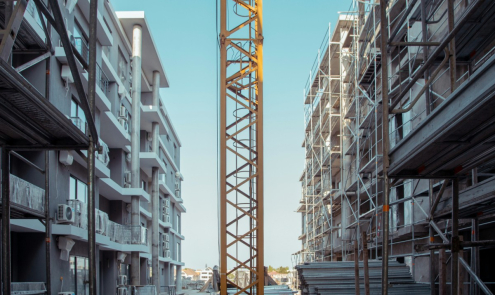ACOUSTIC REGULATIONS AMPLIFY CONCERNS FOR UK RESIDENTS
28 Jun 2024
In the UK, acoustic regulations for residential buildings often mean that occupants are advised to keep their windows closed, even during the hotter summer months. This is increasing the likelihood of overheating and discomfort during the night, forcing a choice between acoustic and thermal comfort.
In the UK, acoustic regulations for residential buildings often mean that occupants are advised to keep their windows closed, even during the hotter summer months. This is increasing the likelihood of overheating and discomfort during the night, forcing a choice between acoustic and thermal comfort. Jason Tramontano & Ellen Huelin, Technical Director and Sustainability Director at Whitecode Consulting, discussed the challenges the built environment is facing when it comes to designing and building residential properties with acoustic regulations in mind.
According to a recent report by the London Mayor, London’s summers are set to become drier and hotter by 2050, with an average summer’s day up to three degrees warmer than current estimates. As a result, occupants in residential buildings are going to be in a difficult position, having to choose between overheating and noise disturbance.
The situation may even get worse, with the Met Office predicting that if carbon emissions are not reduced, 40°C summers could occur every three years by the end of this century. UK buildings often overheat in the summer, which is why the new Part O Building Regulations were introduced to try and mitigate this issue in new homes.
What are the regulations?
Introduced in 2022, the Approved Document Part O updates were intended to help reduce the risk of overheating within residential new builds. Alongside this, Part L was also updated to reduce carbon emissions in line with the government target of net zero by 2050. As a result, modern house design and construction is now focused on energy efficiency, with buildings able to efficiently retain heat while also attempting to pasively limit and remove excess heat in the summer months.
Ordinarily, residential buildings would deal with overheating through passive measures, such as opening windows without requiring additional means such as increased mechanical ventilation flow rates, tempered air or comfort cooling. As such, the regulations approach the subject on a basis of prevention and remedy, aiming at limiting the amount of direct sunlight through windows and glazing and advising ways of removing excess heat from inside the room. However, the solution we are seeing over and over again is to provide additional cooling via mechanical means rather than passively. Can this be remedied by incorporating passive means early on the design?
To achieve Part O regulations, the simplified method restricts windows to a maximum size, depending on the floor area of the room, the direction the windows face, cross-ventilation inside the building, and if the building is in a high-risk area, such as London. More often than not, the window sizes exceed this maximum allowance or do not have enough openings to meet the free area requirements. The dynamic simulation method is therefore used to show compliance with TM59 and Part O, for the majority of sites. This allows further flexibility in the design and enables window openings to be determined in the model, particularly important if there are acoustic constraints.
What does this mean for occupants in residential properties?
The approved document highlights the fact that in areas where external noise is often a problem, the residents of the building will be more likely to keep windows closed.
As such, the relationship between noise reduction and overheating is interconnected, since minimising noise disturbance by keeping windows closed will inevitably increase the chance of the room overheating. Conversely, opening windows and improving ventilation will potentially keep the room cooler but also reduce the effects of sound insulation and adherence to acoustic regulations.
Occupants of popular residential buildings, especially those in busy city centres, such as London, are therefore in a difficult position, where they must choose between noise disturbance and overheating.
The challenges we are facing
The ideal approach to dealing with overheating is to provide external shading to windows and ensure that windows can be openable, particularly overnight, to allow passive ventilation. However, as already mentioned there are further considerations within Part O related to acoustic constraints and risk of falling.
Where acoustic constraints are in place, and the design has been complete, there are very few options to mitigate the risk of overheating. These usually involve boosted mechanical ventilation, the introduction of tempered air cooling or worst case, full cooling. The introduction of enhanced mechanical ventilation results in an increased cost to the developer as well as increased cost to the occupant.
Additionally, increasing mechanical ventilation will often see an increase in ventilation unit and duct size. Aside from increasing noise levels, it’s also going to be difficult to achieve the temperatures required to comply with Part O building regulations.
While incorporating acoustic openings in the façade can be considered as a suitable mitigation of overheating, the acoustic performance can lead to restricted free areas. Consequently, there won’t be enough natural ventilation to cool the rooms.
With sustainability and decarbonisation an important focus of building designers and developers given the government’s 2050 net zero target, heat pumps have become increasingly popular ways of heating UK buildings. However, they can also be utilised to work in reverse and provide effective levels of cooling.
This is a potential resolution to the problem of overheating in residential premises, however heat pumps can lead to an increase in energy usage. Plus, the plant usage needed to achieve overheating compliance can actually see an increase in noise levels.
What can be done?
With the acoustic restrictions likely to lead to overheating in residential developments in major UK cities, such as London, Part O identified acoustic levels indicating where occupants are likely to keep windows closed due to noise disruption.
Passive measured for reducing the risk of overheating need to be considered at an early stage. Increasing energy usage through mechanical means, increasing ventilation flow rates, incorporating tempered air or comfort cooling should be used as a last resort if all passive measures are not deemed feasible.
Examples of passive measures to be considered are as follows:
- Sound absorption on balcony structure
- External shading
- Sliding acoustic screens allowing windows to remain fully open, these could also increase security if lockable
- Attenuated louvres on the external wall
Producing example dwellings within a dynamic thermal model at an early stage of the design can help ascertain which of the passive measures will provide the best results and compliance with Part O to avoid unwanted additional energy use and increased energy bills.
The hotter temperatures will soon be upon us, so now is the time for contractors, property developers, and building owners to seek advice from experienced MEP consultants and mitigate the potential risks of overheating.
Whitecode Consulting is one of the UK’s leading MEP consultancy firms, offering clients from across the UK comprehensive guidance on designing and building energy efficient, sustainable, and durable residential and commercial buildings.

The Role of MEP Surveys in Cost Management...
MEP surveys are essential for assessing the condition and efficiency of mechanical, electrical, and plumbing (MEP) systems in buildings.
Read More
IS THE TRANSITION TO HEAT PUMPS WORTH THE...
As we contend with the global need to reduce carbon emissions and combat climate change, the UK government is introducing bold initiatives to transition away from fossil fuels. One such initiative is the ban on new gas boilers,...
Read MoreLike to Know More? Let's Talk...







